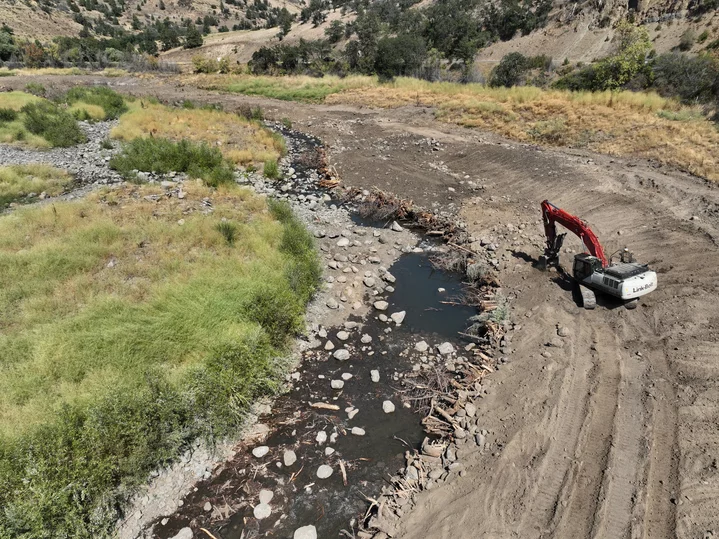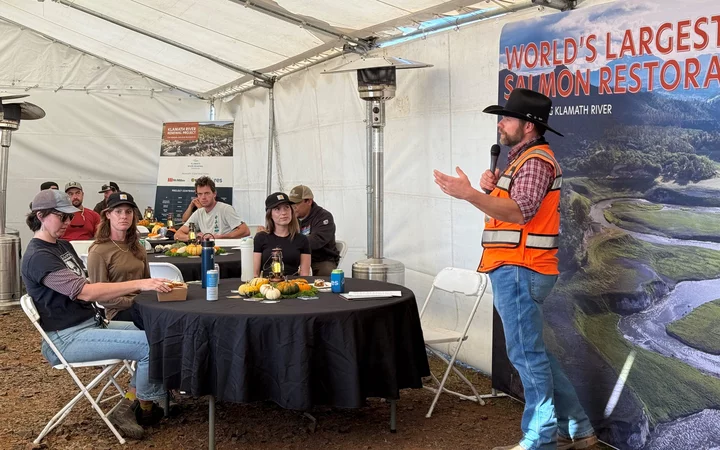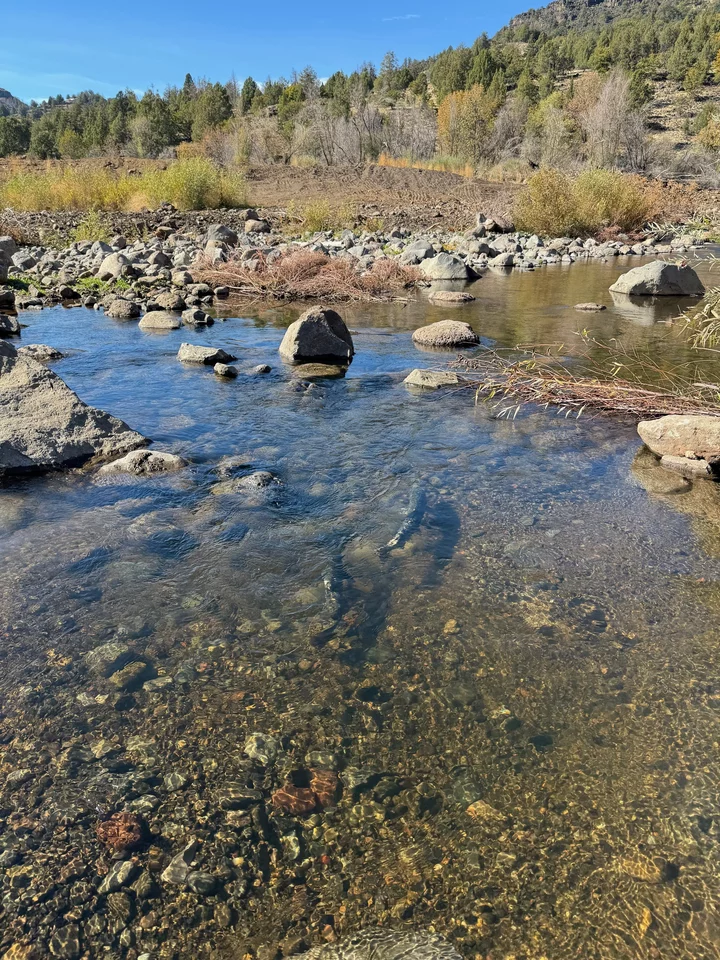Heavy machinery was utilized at Jenny Creek to place boulders and trees to slow the water and add habitat complexity for fish and insects.
Press release from Resource Environmental Solutions:
Hornbrook, CA – The end of construction activity on four priority tributaries to the Klamath River was marked with a “restoration celebration” hosted by Resource Environmental Solutions (RES) and attended last week by tribal leaders, contractors and others.
As restoration contractor for the Klamath River Renewal project, RES led the effort to rehabilitate these key tributaries using a large playbook of stream restoration designs and practices. Collectively, these four tributaries historically had provided over 25 miles of high-quality habitat for salmon and steelhead. Each one was rendered inaccessible to these species by four dams constructed in the first half of the 1900s.
The dams were removed in January 2024 as phase one of the largest dam removal and river restoration in the world. In the second phase, stream restoration designs were finalized as reservoir waters receded and historical stream channels became accessible. During the decades these sections of the tributaries were inundated, their natural structures were deeply impaired. Flow patterns, the deposition of sediment, and a healthy riparian zone were all altered, inhibiting key habitat features that returning salmon and steelhead require to spawn and thrive.
“The surgery is over, and the healing of this key salmon habitat can begin,” said Dave Coffman, Director of Northern California and Oregon Operations and leader of the overall restoration effort for RES. “From the dam removal work in 2024 to the stream reconstruction effort led by RES, the major structural interventions needed to restore the river and these key tributaries is complete.”
Primary RES contractors for the stream restoration include the Yurok Tribe Construction Corporation and Stantec. RES led an “adaptive design” process that tied permitting and agency approval to the realities that terrain would only be exposed after the reservoirs were drained. RES and Stantec developed 60% designs before dam removal and adapted them to actual conditions post dam removal.
The Yurok Tribe Construction Corporation, in coordination with the Yurok Tribe Fisheries Department, was the primary implementer of the stream reconstruction on Scotch, Camp, and Jenny Creeks, including re-grading streambank slopes to reconnect floodplains. RES’ in-house team performed restoration construction work at Beaver Creek. Large wood placement, boulder habitat structures, and beaver dam analogs were features of the restoration of nearly 3.5 miles of creeks.
“We brought an intense effort to bear on these four creeks, all in far northern California,” said Coffman. “If you think of the Klamath River as a highway, tributaries are ‘exits’ that salmon can take to get home. These are places salmon historically selected as spawning and rearing habitat, and we want to welcome them back.”
Coffman noted that if the area had not received major rehabilitation, the creeks would have featured steep banks disconnected from the floodplain and would have no large wood in the streams to slow the water down and provide cover and insect habitat. Ongoing erosion would have impaired water quality for years to come, he said.
Dave Coffman of RES congratulates Yurok Tribal members and others involved in restoring key Klamath River tributaries as part the largest dam removal and river restoration in the world.
RES and the Yurok Tribe worked over the past several months to implement stream design and restoration efforts, reconfiguring stream channels to ensure upstream fish passage and restoring habitat for fish spawning and rearing of young.
“This was a dedicated crew,” said Coffman. “A lot of our team essentially lived on the site, putting in 14-to-16-hour days before the window for ‘in-water’ work closed. The entire team was aligned on the importance of this work, and seeing salmon reoccupy the habitat so quickly reinforced the critical nature of completing this massive effort ahead of schedule. I’m proud of the team that came together to make the vision a reality.”
In addition to reconfiguring and restoring stream channels, restoration teams removed hundreds of thousands of cubic yards of excess sediment, relocating it within the former reservoir footprints.
The restoration work took place on land that was home to the Shasta Indian Nation until the Tribe was forcibly removed a century ago to make way for the construction of Copco Dam. Tribal leaders were on hand to celebrate the restoration work.
“Restoration ensures a healthy river for fish, and it also restores the landscape as Shasta people return to Kikaceki,” said Sami Jo Difuntorum, Cultural Preservation Officer for the Tribe. “It is very humbling to see the salmon return in the restored tributaries. It gives us so much hope for the future health of the river and the people as we heal together.”
Phillip Williams, a Yurok Tribe Council member who also serves as President of the Yurok Tribe Construction Corporation, was visibly moved as he discussed the role of the Tribe in healing the Klamath River.
“We are watching a lasting legacy unfold before our very eyes. The Creator is blessing us, and the restoration crews are the tools used to heal the Klamath Basin. Hundreds of salmon are returning home to Jenny Creek. Every fish that spawns represents the hope of a better future for the Klamath River communities,” he said.
Dan Chase, the Director of Fisheries, Aquatics & Design for RES, noted that the restoration work will vastly improve habitat conditions for salmon, steelhead, lamprey, and other native species in areas that were previously inundated with stagnant water seasonally choked with toxic algae.
“Reshaping channels and rebuilding floodplain function creates the foundation for resilient, shaded, and dynamic stream corridors that support diverse aquatic life,” said Chase. “Dam removal made the entire river once again accessible to fish, but restoration makes the previously damaged streams hospitable to them.”
Chase said the entire project team was keenly aware of the sensitivity of working in these newly emerged creeks where young, endangered fish were rearing.
“We captured and relocated juvenile salmon and steelhead ahead of construction, protected turtles and nesting birds, monitored water quality, and safeguarded cultural resources with tribal oversight,” said Chase. “Our tribal partners have often said that we are not only restoring the river, but also a way of life vital to Native American communities who have depended on the river since time immemorial. Everyone involved in this epic project has felt the enormity of the task.”
Salmon have recently returned to spawn in Jenny Creek, one of four high-priority tributaries restored under a plan crafted by RES. A portion of Jenny Creek was covered in up to 40 feet of algae choked reservoir water until Klamath River dams were removed.



CLICK TO MANAGE